-
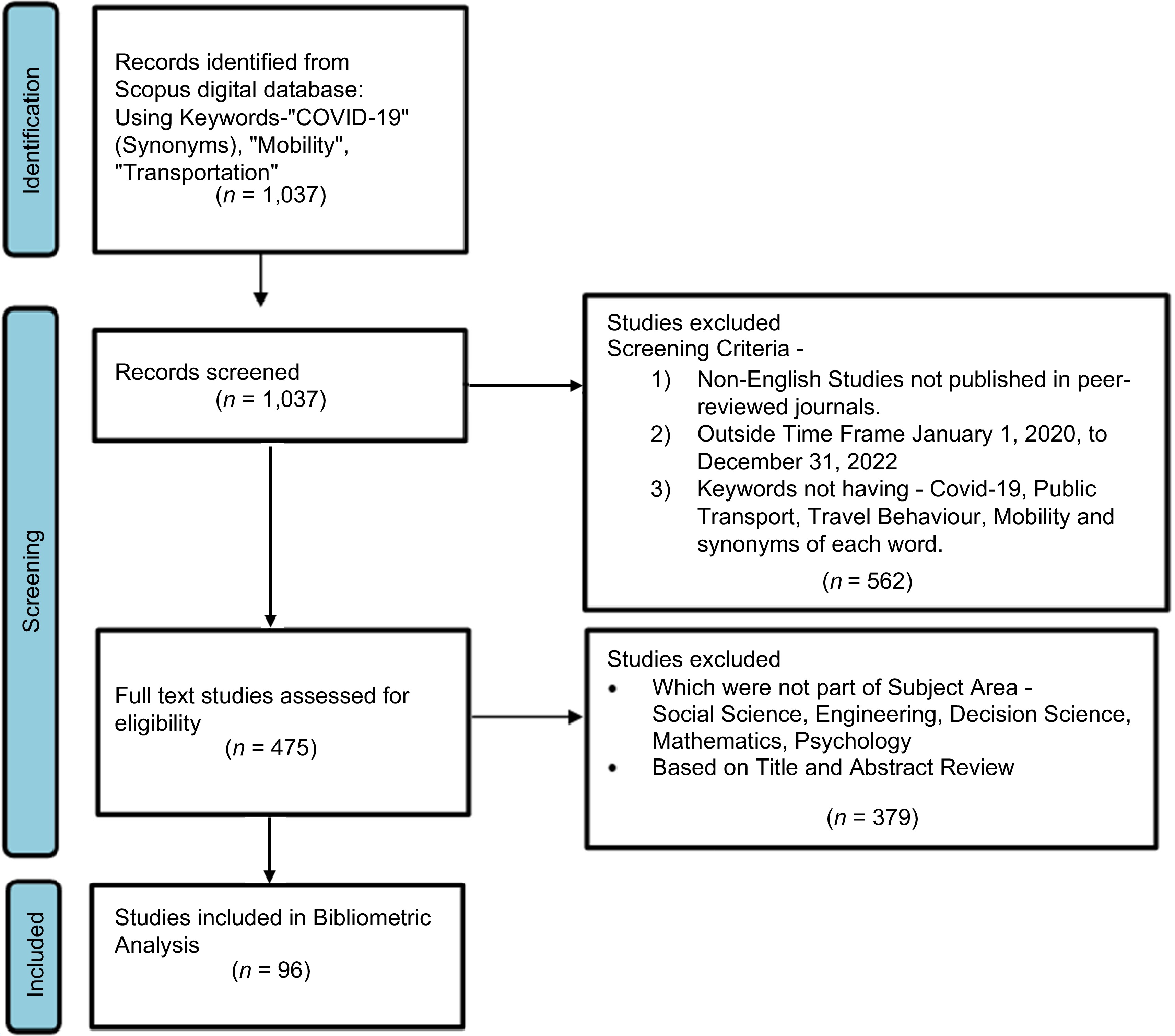
Figure 1.
The three-phased PRISMA (2022) diagram of the literature selection process.
-
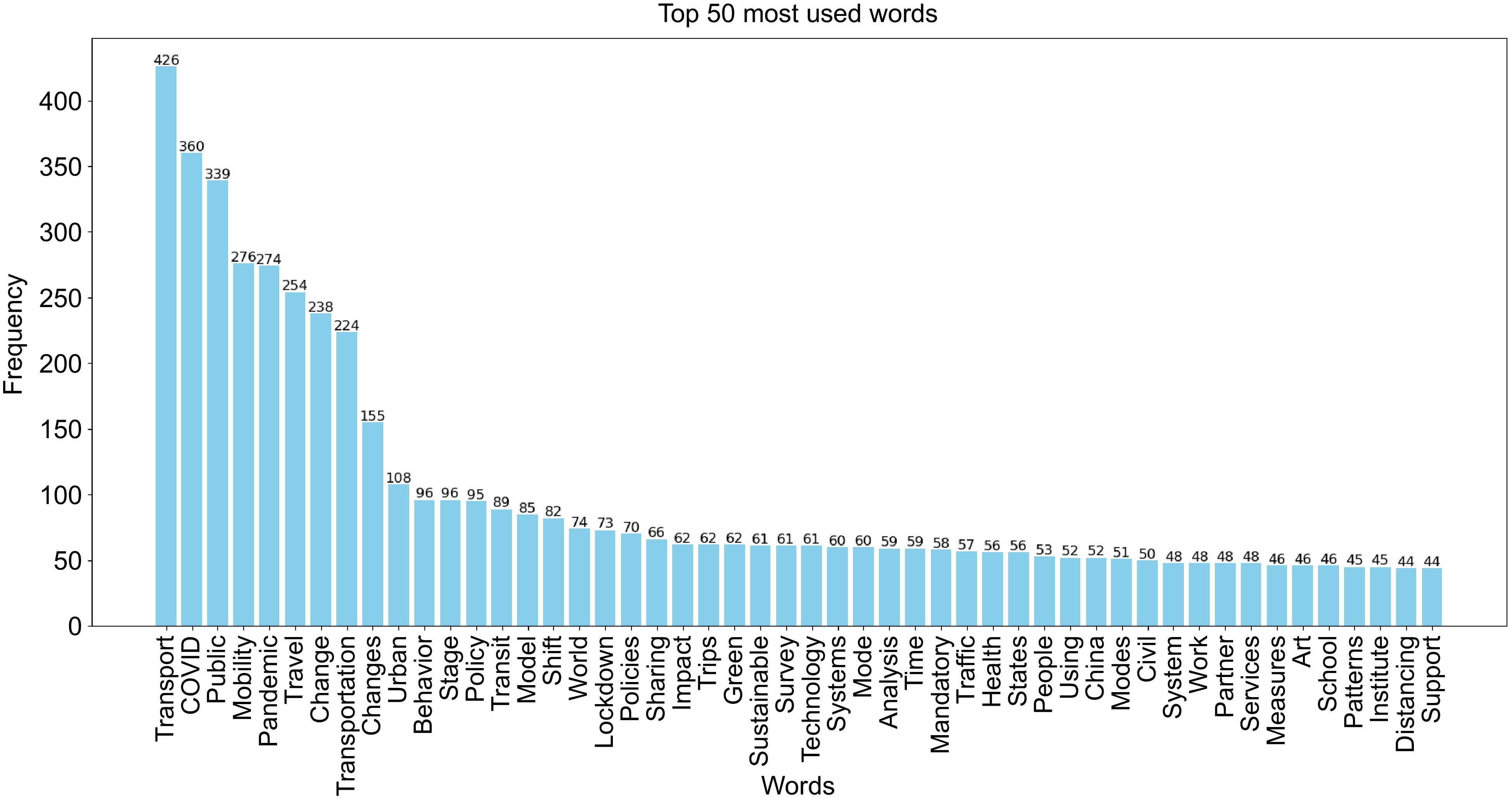
Figure 2.
Frequencies of the top 50 most used words in article abstracts.
-
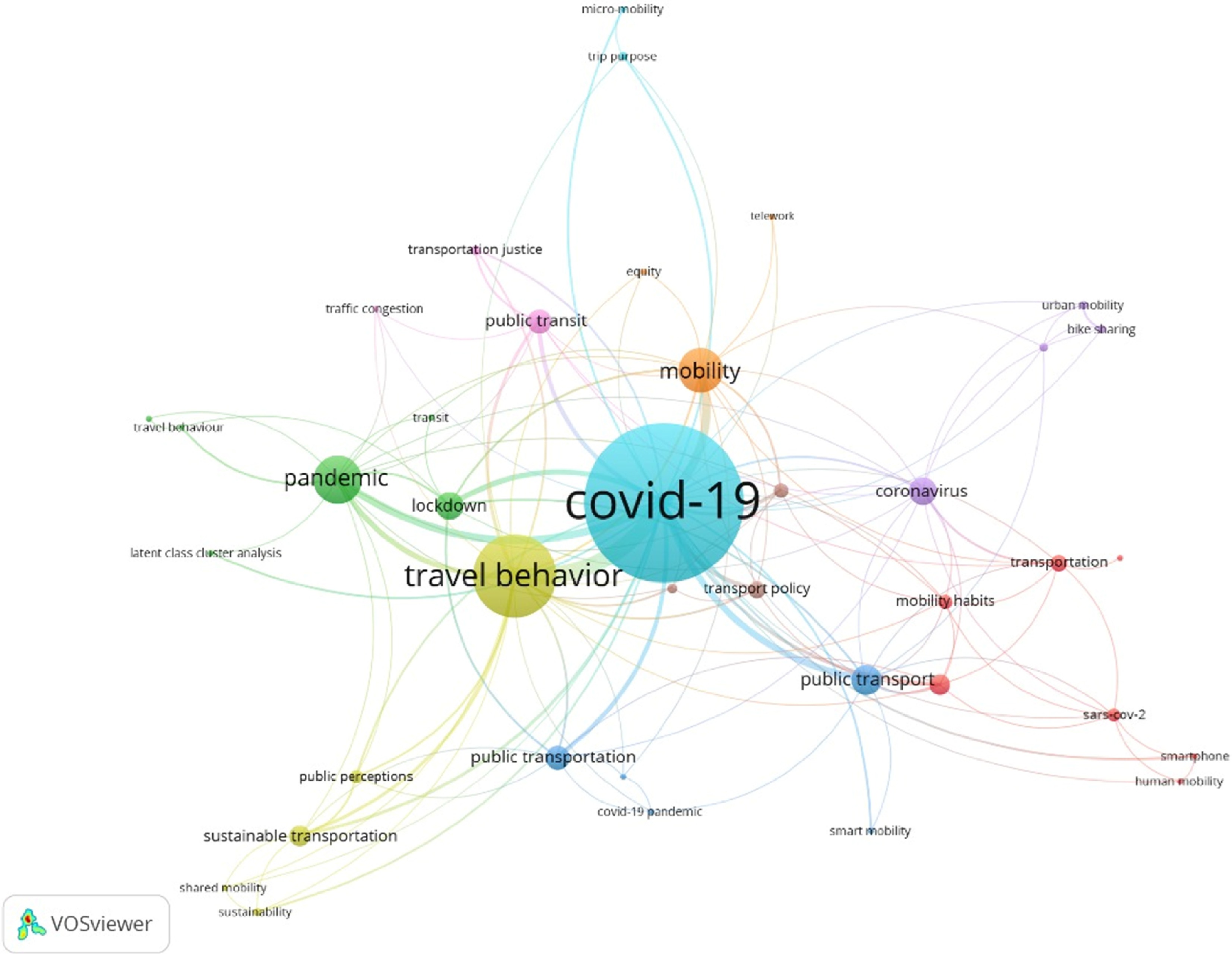
Figure 3.
Keyword Co-Occurrence of 96 papers.
-
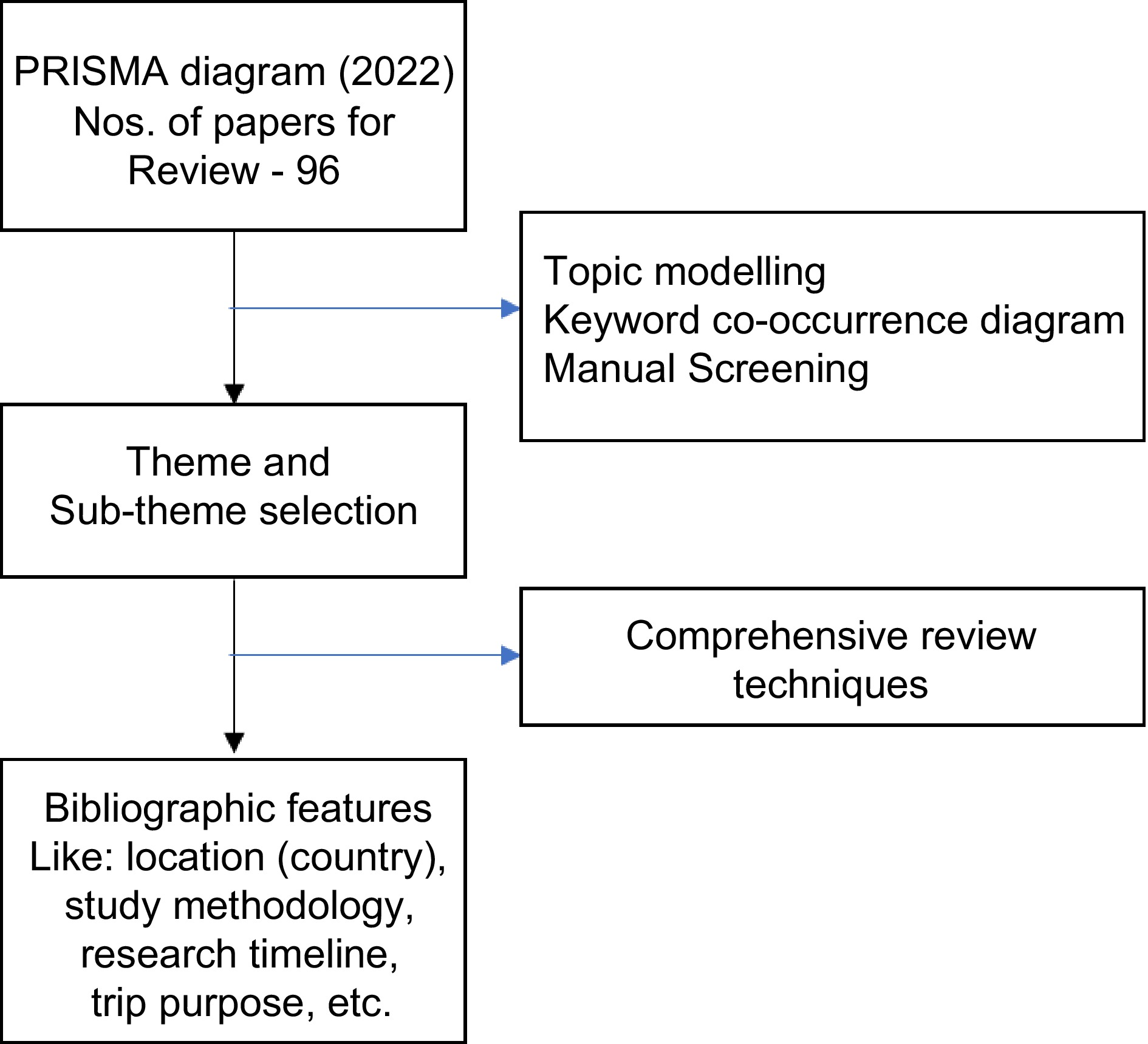
Figure 4.
Research workflow.
-

Figure 5.
Articles from different journals considered for detailed review and analysis.
-

Figure 6.
Lockdown initiation date and origin location of the analyzed articles.
-
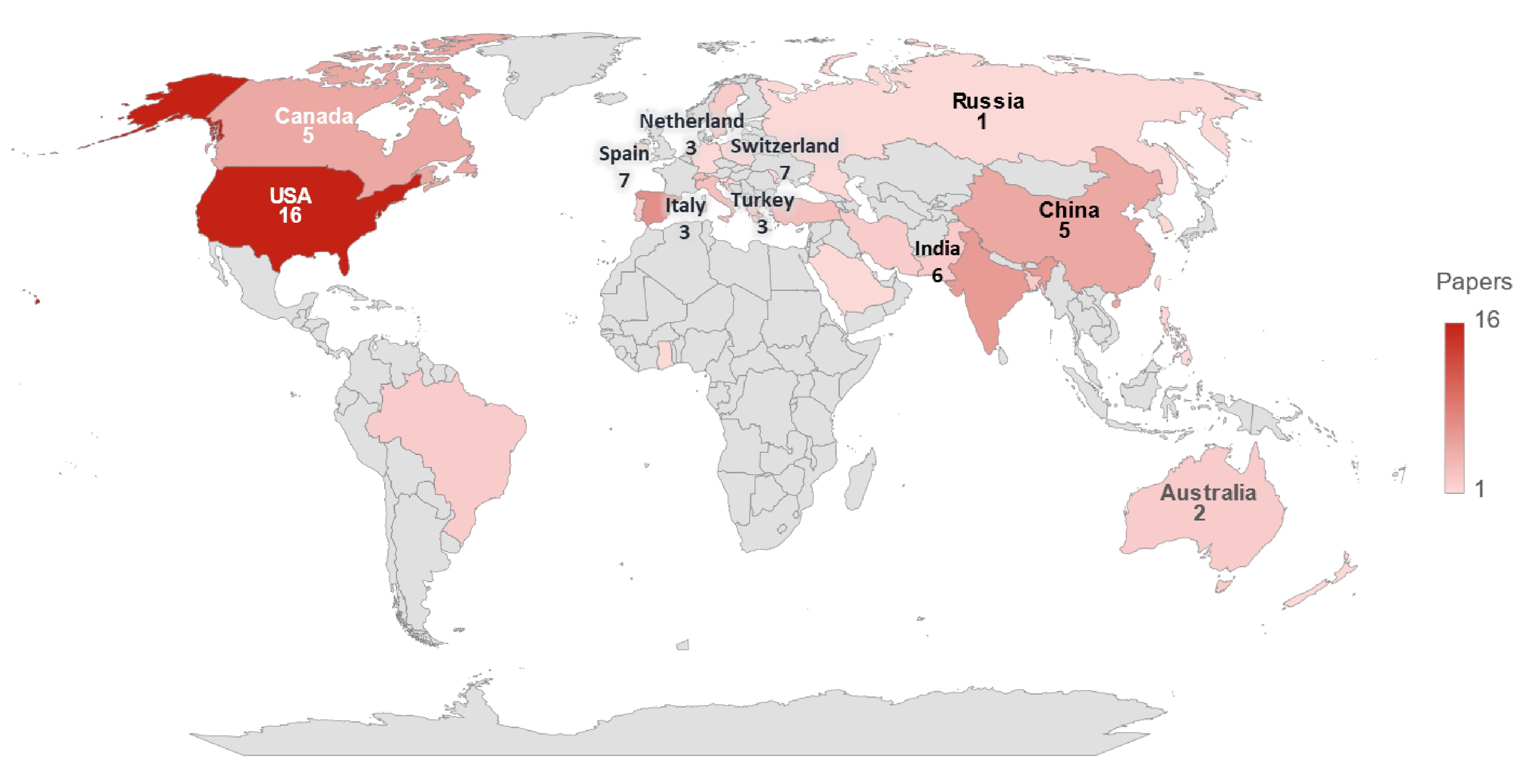
Figure 7.
Distribution of countries based on research location (highlighting the top 10 countries).
-
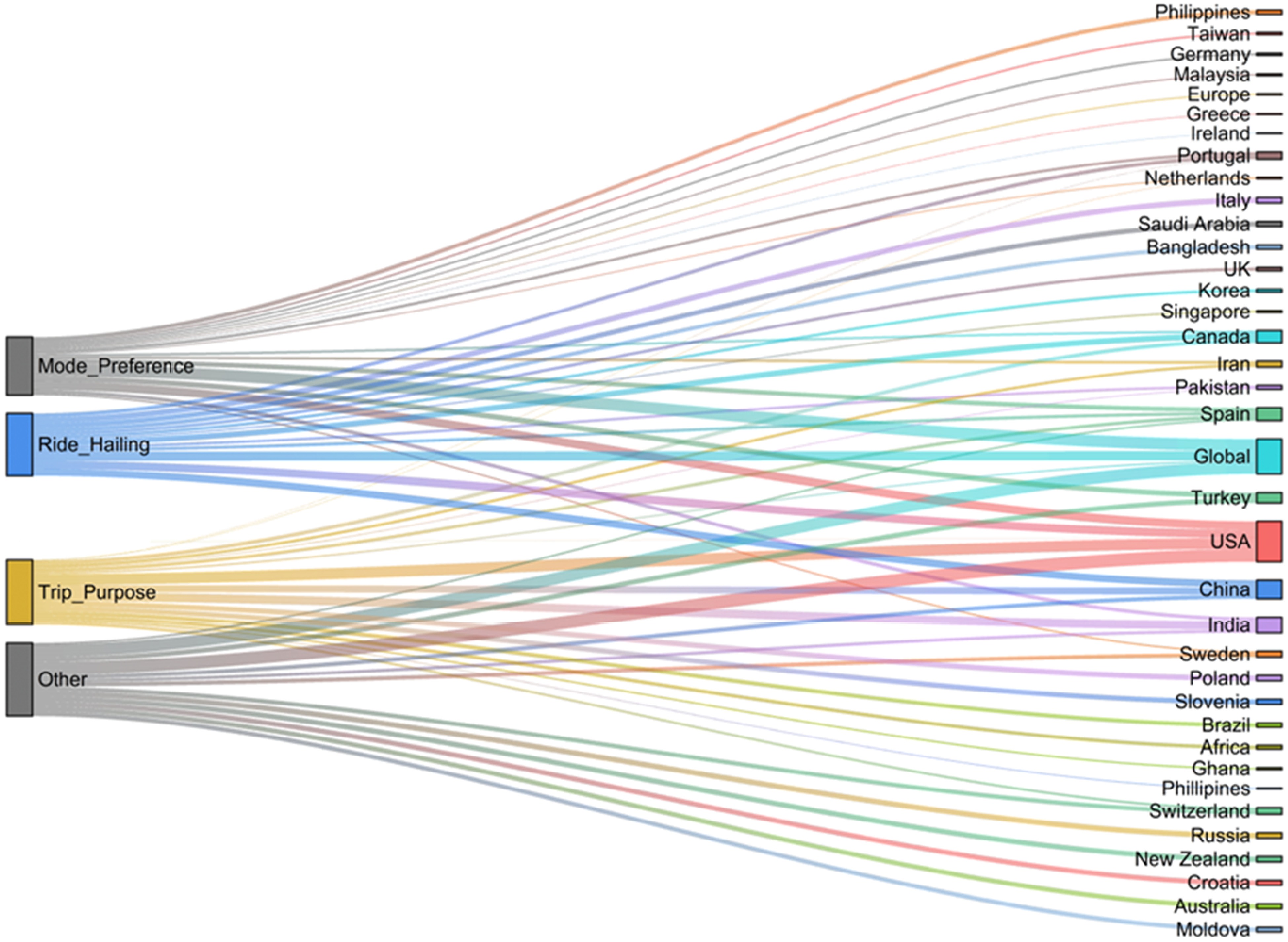
Figure 8.
Sankey diagram showing country of origin of the articles from three focal themes.
-
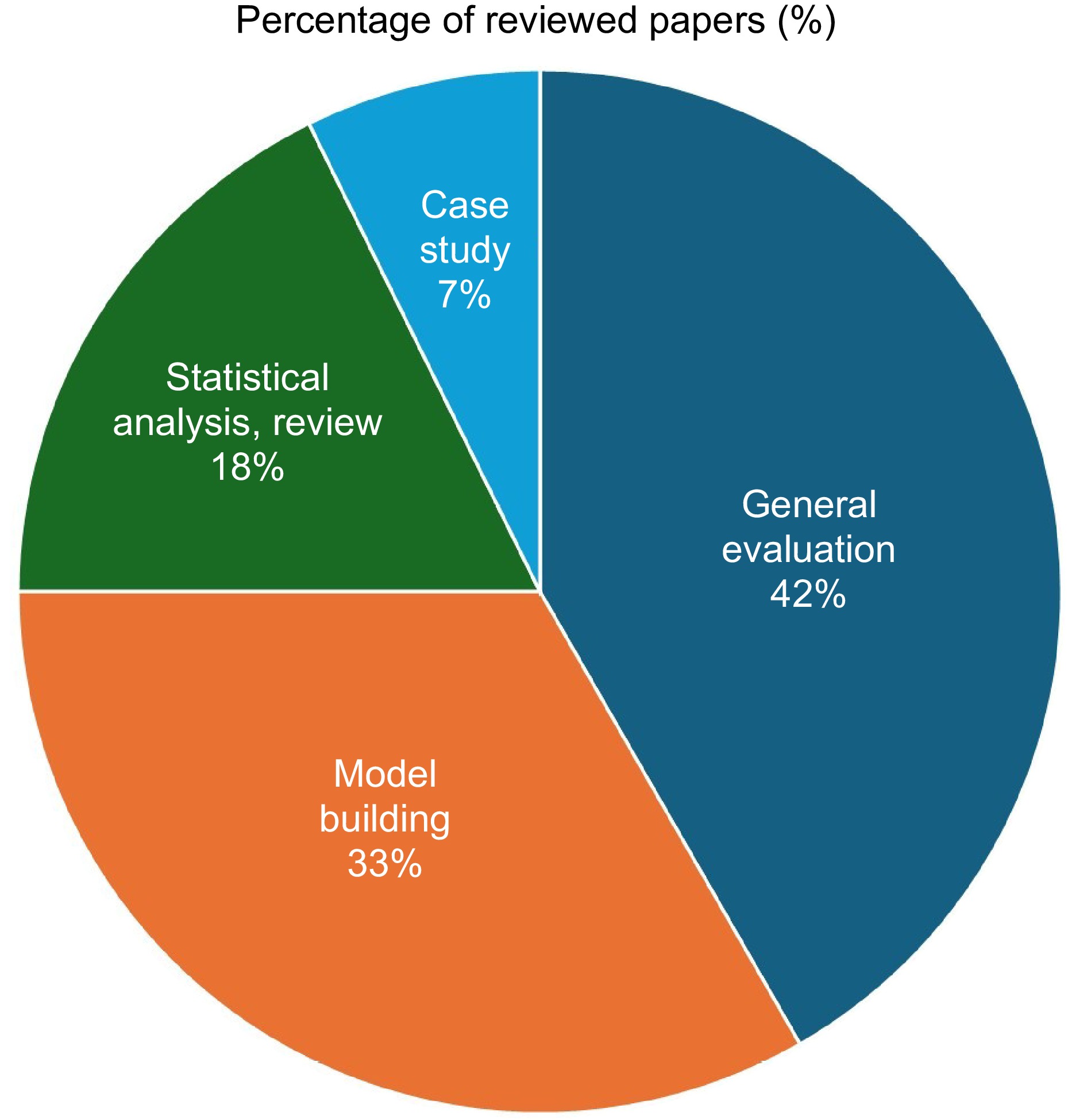
Figure 9.
Analysis methodology adopted across 96 articles.
-
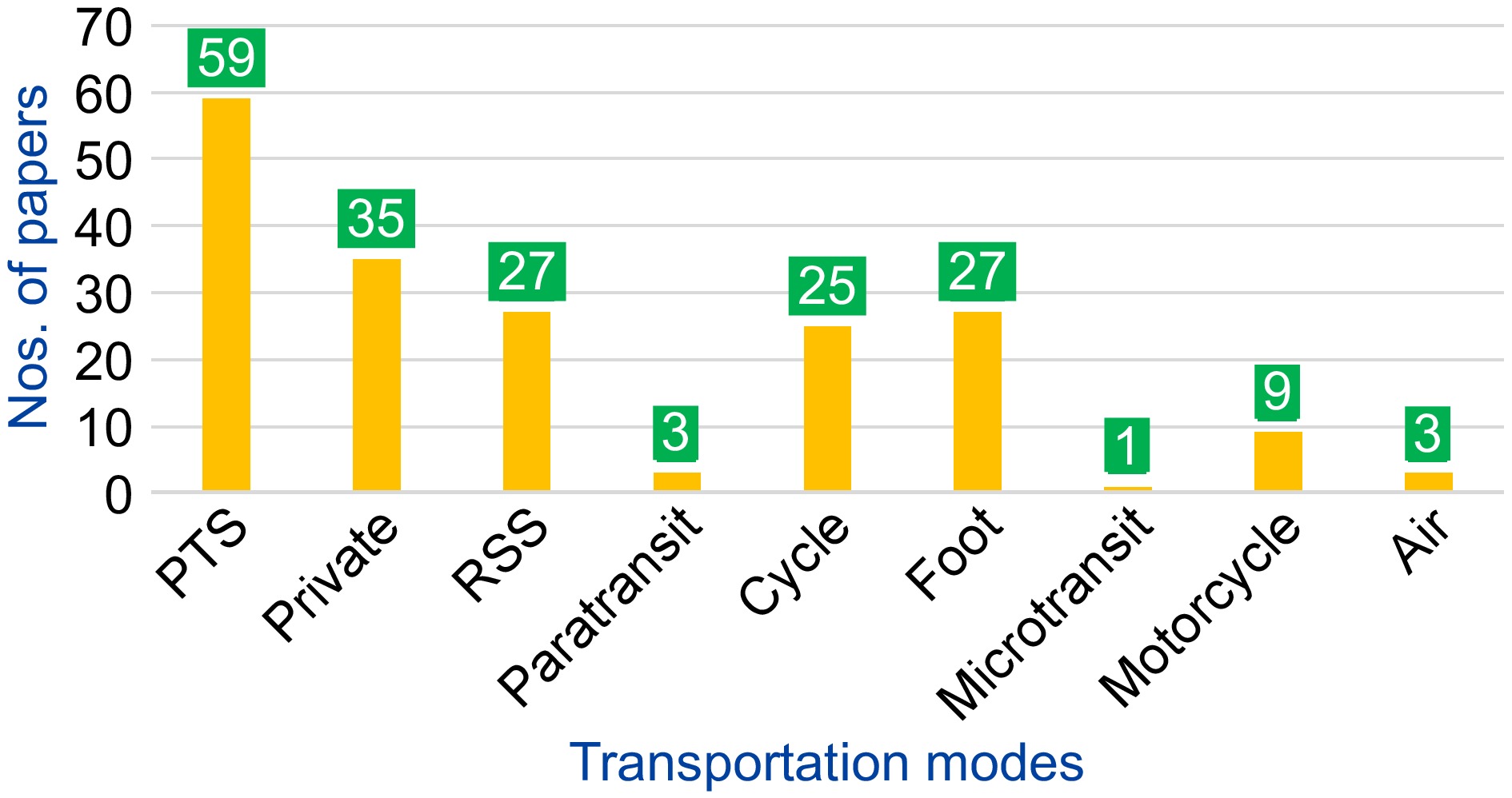
Figure 10.
Number of papers mentioning the listed transportation modes.
-
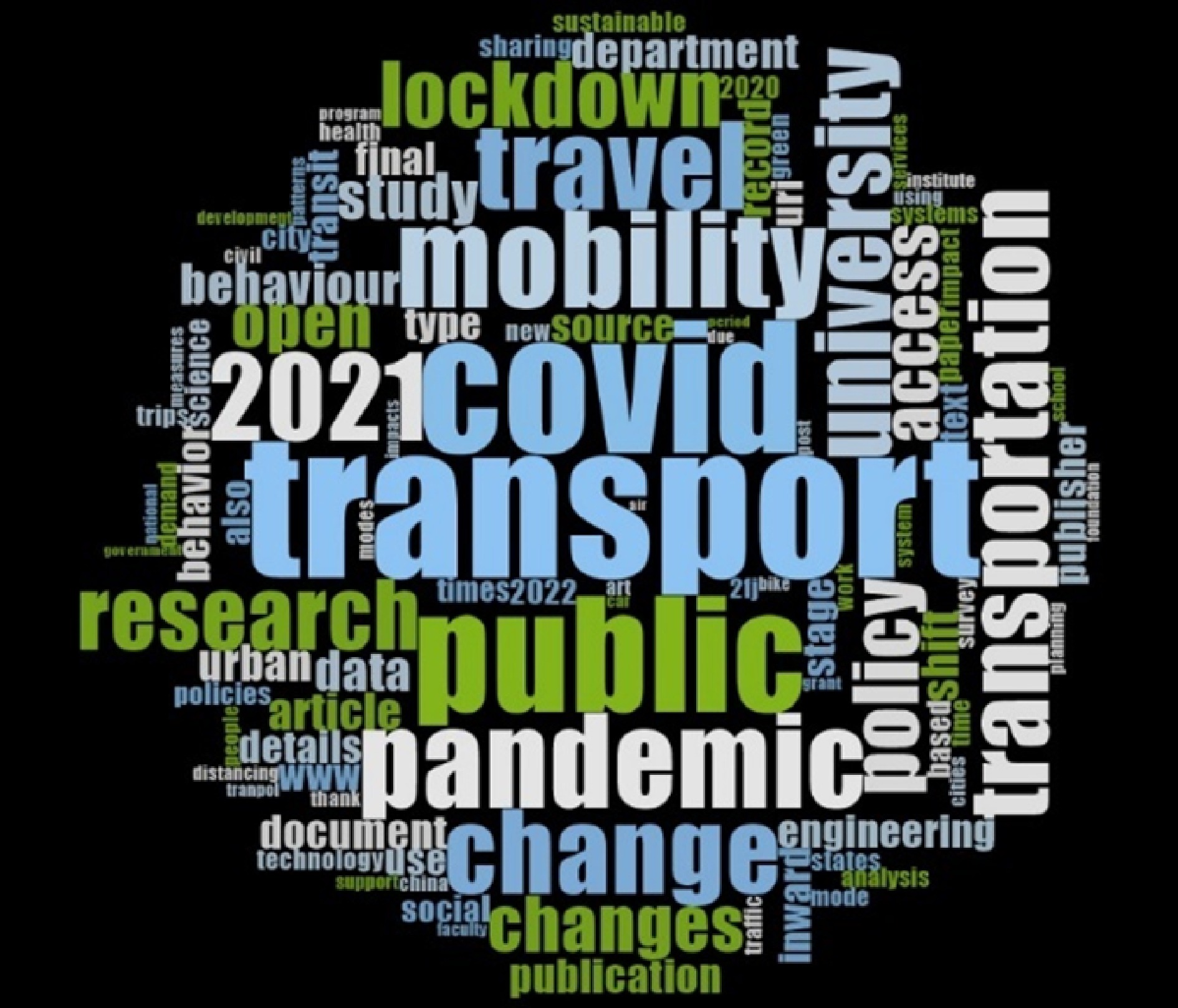
Figure 11.
Word cloud with the top 50 words from keyword analysis.
-
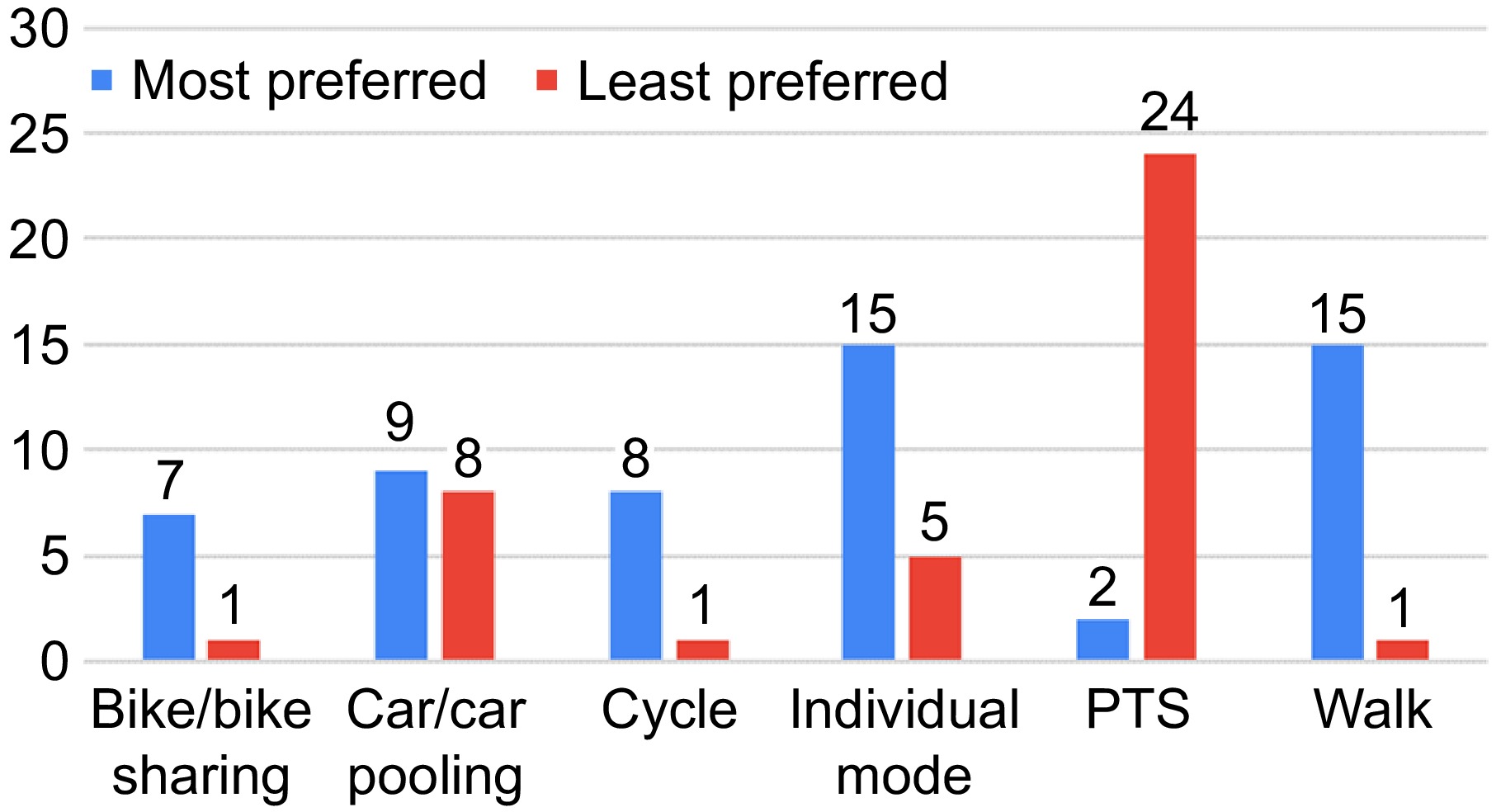
Figure 12.
Comparison between most preferred and least preferred transportation modes.
-
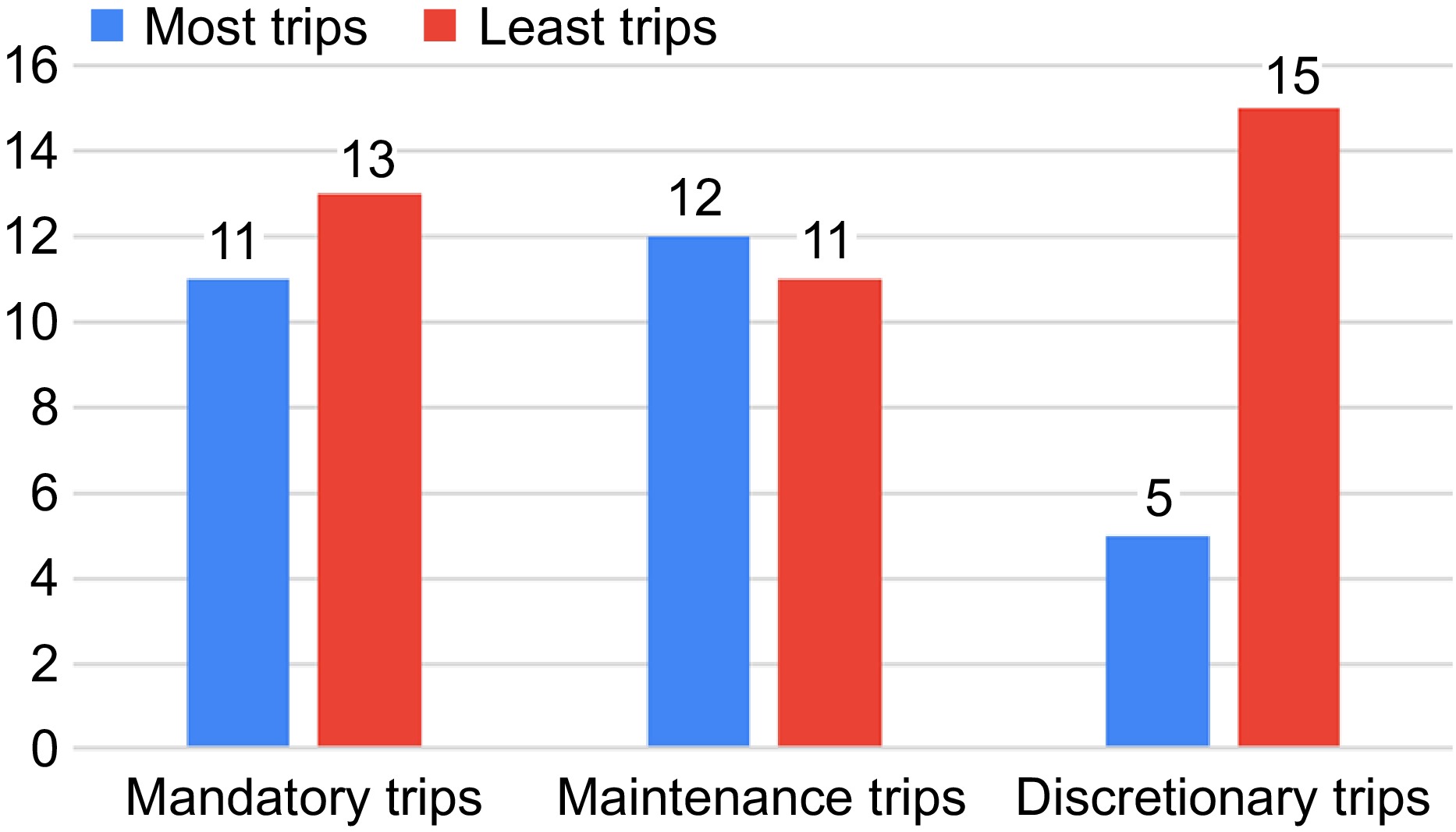
Figure 13.
Mode choice preference by percentage.
-
Keywords of different colored clusters (Fig. 3) Theme considerations after manual checking Telework Impact on Ride Hailing Services:
In this theme, keywords and topics related to shared modes of transport, ride hailing services obtained via smartphone/tele networks, sustainable transportations used in ride hailing services and smart mobility options were considered.Bike sharing Transport policy Sustainable transportation Smart mobility Smartphone Shared mobility Sustainability Micro mobility Impact on Mode Preference:
In this theme, keywords and topics related to different types of modes like public transportation, micromobility options, motorized mobility and mobility habits and choices that affected mode choices were considered.Public transit Transit Mode choice Mobility habits Public transportation Public transport Trip purpose Impact on Trip Purpose:
In this theme, keywords and topics related to travel behavior and public perceptions regarding mobility that affected trip purpose were considered. In addition, the effect of traffic congestion was also taken into account.Traffic congestion Travel behavior Public perceptions Urban mobility Common Themes/Search Terms:
COVID-19 and its synonyms used throughout different literature were taken into consideration. For mobility, its synonyms were also considered.Human mobility Mobility Pandemic Lockdown Covid-19 Corona virus Transportation Sars Cov-2 Covid-19 pandemic Equity Other Items:
These keywords came out as prominent in different literature.Transportation justice Machine learning Latent class cluster analysis Table 1.
Theme considerations of keywords from different colored clusters.
-
Major theme Ref. Sub-theme Keywords Impact on Ride
Hailing Services[9−31]
Overlapped with Major Theme: Impact on Mode Preference − [46, 49, 51]
Overlapped with Major Theme: Impact on Trip
Purpose − [69, 97]Change of Demand and Usage Anthropogenic air pollution, autonomous public transport, autonomous vehicles, bicycles, bike sharing, bike sharing system, car use, COVID-19, case studies, demand responsive transport, diseases, disease prevention, emerging mobility, epidemic and pandemic, human and behavioral factors, information and communications technology (ICT), instrumental variables, literature review, modal shift dynamics, ordinal logistic regression, public transportation, public transport, ridership, safety perceptions, Seoul, sharing anxiety, smart cities, smart city, social factors, transportation demand, transportation policy, travel behavior, travel characteristics, urban form, urban mobility, urban planning Rise of
MicromobilityActive travel, bike sharing system, causal inference, cycling, COVID-19, e-scooter sharing system, food purchases, transportation means, spatial coupling, travel behavior, Saudi Arabia, spatiotemporal mean, user perception, lockdown, lockdown citi bike usage, urban greenway, micro-mobility, infrastructure intervention, mobility-as-service, natural experiment, yellow taxi demand, propensity score regression discontinuity Shift in service offering and safety measures Accident, car sharing usage, China, COVID-19, discrete choice modeling, generalized regret minimization, Heckman modeling, lockdown, ordered logit model, pandemic times, perception of risk, post-COVID-19 travel behavior, post-COVID-19 mobility public transport, random regret minimization, random utility maximization, ride-sourcing, road safety, shared mobility, sharing mobility, smartphone, sustainability, transport equity, travel behavior, travel mode choice, urban infrastructure, urban mobility, factor analysis, bike sharing motivations, perceived accessibility, sustainable transportation Socioeconomic Disparities Causal inference, coronavirus, COVID-19, COVID-19 effects, demand forecasting, discriminative pattern mining, health impacts, high-speed rail, instrumental variables, interpersonal distancing, mobility habits, mobility, multimodality, order-preserving traffic dynamics, public transport, recovery, ride-sharing, smartphone, suburban rail services, sustainable mobility, train capacity, transport equity, transportation, transportation planning, perceived accessibility, public transportation, lifestyle, teleworking, residential location Impact on Mode Preference [1−3,8,32−68]
Overlapped with Major Theme: Impact on Ride
Hailing Services −
[10, 12, 17, 21, 29, 31]
Overlapped with Major Theme: Impact on Trip
Purpose − [71, 76, 86, 87, 95]Personal Vehicles Active travel, anthropogenic air pollution, bluetooth traffic monitoring system, COVID-19, disease prevention, equity, generalized linear mixed effects mode, Google and Apple mobility data, greenhouse gas emissions, healthy cities, Indian cities, mobile device data, mobility, mobility-shift, multi-disciplinary, post-pandemic, prediction, public transport, resilient public transport, smart card data, smart mobility, transport modes, transport policy India, transportation demand, travel behavior, travel modes, university students, transportation, travel behavior, modal share, level of urbanization, lockdown, Slovenia Towards Public Transportation and Shared mobility Bicycles, big data analysis, bike sharing motivations, bike-sharing system, biking Barcelona, Bluetooth traffic monitoring system, capacity management, case studies, case study, commuting, coronavirus, COVID-19, diseases, dockless bike-share system, emergency, epidemic and pandemic, factor analysis, food purchases, health impacts, homelessness, human and behavioral factors, inequality, infection fear, lockdown, lockdown CITI bike usage, longitudinal case study, mixed methods, mobility, mobility behavior, mobility change, mobility habits, mode shift, new normal, pandemic, prediction, probabilistic machine learning, propensity score regression discontinuity, public perceptions, public transit, public transport, public transport networks, public transport planning, public transportation, quasi-experimental research, recovery period, resilient transport systems, ridership, rural areas, safety-and-mobility trade-off, sars-cov-2, Seoul, smart card data, smart mobility, social distancing, social equity, social factors, spatial compartmental model, spatial coupling, spatiotemporal, sustainability, sustainable, sustainable mobility, tactical urbanism, teleworking, transit, transport and mobility related inequalities, transport and society, transport policy, transportation, transportation justice, transportation means, transportation planning, travel behavior, urban mobility, work from home, yellow taxi demand, Air quality index, COVID-19 response Active Transportation Activity-travel, best-worst scaling, bike-sharing system, biking Barcelona, built environment, central businesses district (CBD), corona, COVID-19, daily commuting, discrete choice, equity, generalized linear mixed effects mode, google and apple mobility data, google mobility report, Indian cities, mobile device data, mobility, modal choice, mode choice, pandemic, passenger transport, person-miles traveled, policy, probabilistic machine learning, public transport, quasi-experimental research, smart city, social impact, structural equation modeling, sustainability, sustainable mobility, tactical urbanism, telecommuting, traffic psychology, transport, transport policy, travel behavior, travel modes, urban mobility, urban planning, working from home, active travel, bike sharing Impact on Trip Purpose [69−97]
Overlapped with Major Theme: Impact on Ride
Hailing Services − [20]
Overlapped with Major Theme: Impact on Mode Preference −
[34, 37, 55, 65, 67]Mode Choice on
Trip PurposeActivity-travel, activity chain, adaptive travel behavior, Americans with disabilities act (ADA), best-worst scaling, bike sharing systems, car use, causal inference, city periphery, COVID-19, covid-19 effects, COVID-19 strategies, disabled people activities of daily community, discrete choice, discrete choice model, disruptive events, dynamic CGE model, everyday leisure travel, GBDT model, global south, google mobility report, households, hurdle model, intercity bus transport, level of urbanization, lifestyle, lockdown, mobility, mobility patterns under epidemic modal choice, modal share, modal shift dynamics, modal split, non-mandatory activities, older adult, pandemic, paratransit, passenger transport services, people with disabilities, person-miles traveled, policy evaluation, public perceptions, public transit, public transport, public transport networks, public transportation, recovery period, recovery scenarios, residential location, ride-sharing, risk, safety perceptions, service contracting, service quality, Slovenia, social and recreational trips, social distancing, structural equation modeling, sustainable transport, sustainable transportation, telecommuting, teleworking, time-varying, transit, transport, transport and society, transport behavior, transportation equity, travel behavior Behavioral and Socioeconomic Effects Activity space, attitude towards teleworking, auctioning, coronavirus, commuting, COVID-19, daily commuting, demand management, equity, greater bay area (GBA), inequality, inflow control, latent class cluster analysis, mobile phone data, mobility, mobility habits, mode choice, movement control order, o–d flow, pandemic, pricing, public transit, public transport, public transportation, recovery, shopping, shopping trips, social exclusion, social inequity, spatial interaction, sustainable mobility, sustainable mobility, teleworking behavior, tradeable permit schemes, train travelers, transportation, travel behavior, travel frequency, travel patterns, trip purpose, work-based trips Table 2.
Theme and sub-theme distribution of reviewed literature.
Figures
(13)
Tables
(2)